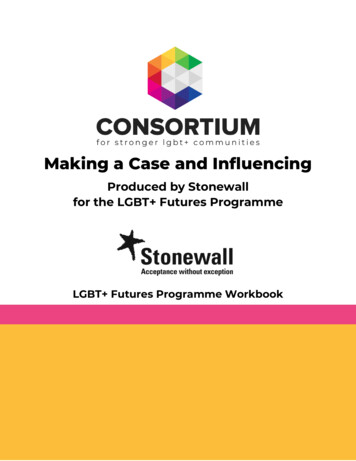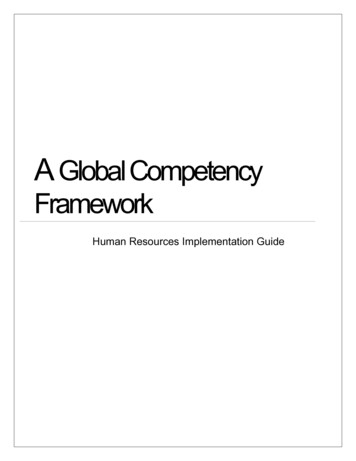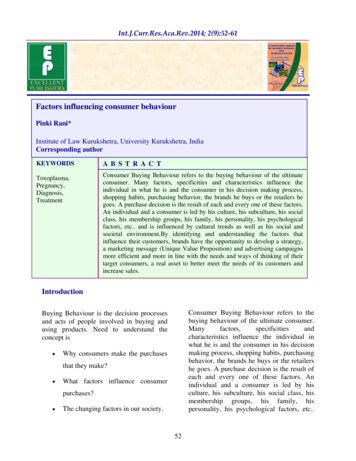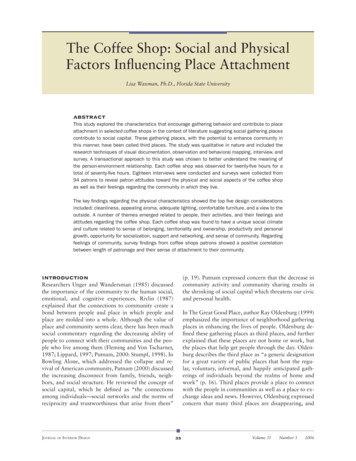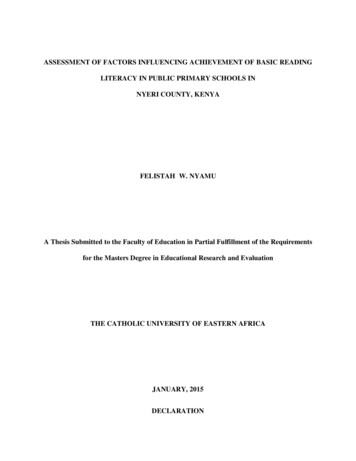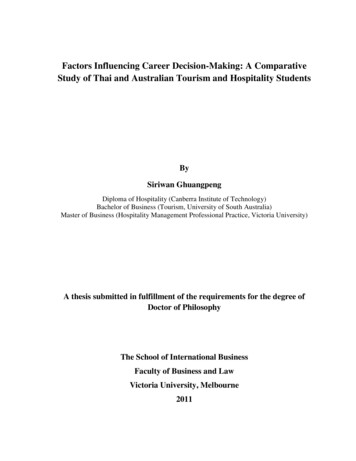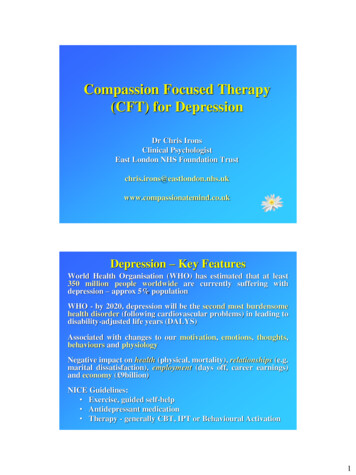
Transcription
#14 INFLUENCING OTHERSINTERVIEW GUIDEPURPOSE OF THE INTERVIEW GUIDE:This Interview Guide is designed to assist in the behavioral interview process. It providesspecific questions and probes for the behaviors of the competency. In addition, positiveand negative behavioral indicators are listed that will help evaluate the candidate’sresponses. While the process described below is designed for multiple interviewersseeing each candidate, it can be completed with only one interviewer.Prior to the interview:Review the candidate’s resume.Review the assigned the competency(s) and the behaviors that compriseeach competency.Select the specific questions you feel comfortable asking each candidate.Note: Not all the questions need to be used – select at least two questions.During the interview:Greet the candidate and spend a few minutes building rapport; talk aboutareas the candidate is interested in.Transition into the formal interview.Ask the selected questions and use follow-up probes to get completeexamples of the:! Situation that the candidate encountered;! Actions that the candidate took;! Results or outcome of the actions taken.Give the candidate time to think about past examples/experiences whenanswering the questions.Ideally get at least 2-3 examples for each question.Use this guide to take notes and evaluate the candidate.Following the interview:Check off appropriate behavioral indicators and summarize key observationsand notes. Rate the candidate on each assigned competencies in the spaceprovided at the bottom of each page.Note any observations for competencies not assigned and be prepared todiscuss.After completing, interviewers should meet to discuss and reach consensuson the final ratings for each candidate and complete the Candidate InterviewSummary.Make the hiring decision.Candidate:Interviewer:Date of Interview: 2015, Workitect, Inc.Influencing Others – 1www.workitect.com
INFLUENCING OTHERSDefinition: The ability to gain others’ support for ideas, proposals, projects, andsolutions.Behaviors:a. Presents arguments that address other’s most important concerns and issuesand looks for win-win solutions.b. Involves others in a process or decision, to ensure their support.c. Offers trade-offs or exchanges, to gain commitment.d. Identifies and proposes solutions that benefit all parties involved in a situation.e. Enlists experts or third parties to influence others.f. Develops other indirect strategies to influence others.g. Knows when to escalate critical issues to own or other’s management, if ownefforts to enlist support have not succeeded.h. Structures situations (e.g., the setting, persons present, sequence of events) tocreate a desired impact and to maximize the chances of a favorable outcome.i. Works to make a particular impression on others.j. Identifies and targets influence efforts at the real decision makers and those whocan influence them.k. Seeks out and builds relationships with others who can provide information,intelligence, career support, potential business, and other forms of help.l. Takes a personal interest in others (e.g., by asking about their concerns,interests, family, friends, hobbies), to develop relationships.m. Accurately anticipates the implications of events or decisions for variousstakeholders in the organization and plans strategy accordingly. 2015, Workitect, Inc.Influencing Others – 2www.workitect.com
Behavioral Questions and Probes1. Share with me an example of when you were proposing an idea or solution to aproblem to your superior(s) and needed to get their “buy in” and support. What didyou do to get “buy-in” and support?What was the situation? What action(s) did you take? What was theresult?2. Tell me about a time you wanted to change a process, procedure, or method ofdoing something in your organization and you knew it would not be very popular.How did you go about making that change in your organization?What was the situation? What action(s) did you take? What was theresult?3. Give me an example of when you were proposing something that was going tocost the organization a significant amount of money to implement. How did you goabout making that proposal?What was the situation? What action(s) did you take? What was theresult?4. Tell me about a time an individual or group in your organization was stronglyopposing you on something (e.g. an idea, a project, etc.). How did you deal withthis person or group?What was the situation? What action(s) did you take? What was theresult?5. Think of a time when you had an employee or team member that you knew wasnot fully supporting and engaged in the work of group/team, and you felt the needto do something about it. What did you do to get their support and get themengaged?What was the situation? What action(s) did you take? What was theresult?6. Share with me an example of a time you had to give an employee an assignmentthat you knew he/she did not like and may not try to do their best at it. How didyou go about giving them the assignment?What was the situation? What action(s) did you take? What was theresult? 2015, Workitect, Inc.Influencing Others – 3www.workitect.com
Positive IndicatorsNegative Indicators" Presents arguments that address other’s most importantconcerns and issues and looks for win-win solutions" Involves others in a process or decision, to ensure theirsupport" Offers trade-offs or exchanges, to gain commitment" Identifies and proposes solutions that benefit all partiesinvolved in a situation" Enlists experts or third parties to influence others" Develops other indirect strategies to influence others" Knows when to escalate critical issues to own or other’smanagement, if own efforts to enlist support have notsucceeded" Structures situations (e.g., the setting, persons present,sequence of events) to create a desired impact and tomaximize the chances of a favorable outcome" Works to make a particular impression on others" Identifies and targets influence efforts at the realdecision makers and those who can influence them" Seeks out and builds relationships with others who canprovide information, intelligence, career support,potential business, and other forms of help" Takes a personal interest in others (e.g., by asking abouttheir concerns, interests, family, friends, hobbies), todevelop relationships" Accurately anticipates the implications of events ordecisions for various stakeholders in the organizationand plans strategy accordingly" Ignores or minimizes the most important concernsand issues of others; does not strive for a win-win" Dictates to others a process or a decision" Will not negotiate to gain commitment" Identifies and proposes solutions that only benefitone party" Does not seek to influence people with thirdparties or indirect strategies" Escalates critical issues to management beforeexhausting other possible methods, or neverescalates critical issues until they are causingmajor problems" Does little to structure situations for desired impactor favorable outcomes" Does not seek to make the right impression onothers" Does not seek to influence the real decisionmakers or those who can influence them" Does little to seek out or build relationships withothers who can help" Not interested in the personal interests of others todevelop relationships" Does not see the future implications of decisionsor events on stakeholders" Fails to foresee, or plan a strategy based on, thefuture implications of decisions or events onstakeholdersNotesOVERALL EVALUATION – INFLUENCING OTHERSStrength AreaDemonstrates ProficiencyImprovementOpportunity""" 2015, Workitect, Inc.Influencing Others – 4www.workitect.com
ALSO AVAILABLEA complete set of Customer Interview Guides, one for each of these 35competencies.A license to use these guides throughout your organization is included with alicense to use Workitect’s Competency Dictionary.Contact us for details at 800-870-9490 or info@workitect.com 2015, Workitect, Inc.Influencing Others – 5www.workitect.com
2015, Workitect, Inc. Influencing Others - 2 www.workitect.com INFLUENCING OTHERS Definition: The ability to gain others' support for ideas, proposals, projects, and solutions. Behaviors: a. Presents arguments that address other's most important concerns and issues and looks for win-win solutions. b. Involves others in a process or .


